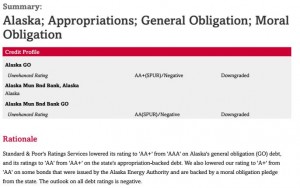
Standard & Poor’s downgraded Alaska’s credit rating Tuesday after months of warnings. With plunging oil prices wreaking havoc on the state’s budget, the agency knocked Alaska down a notch from the top AAA rating it’s held for the last four years.
The credit rating affects how much the state — and local communities — have to pay to borrow money for projects like schools and roads. Tuesday’s change won’t have a huge impact on Alaska’s bottom line. But the downgrade came with a potentially ominous warning.
First things first: Alaska’s credit rating is still pretty good. Standard & Poor’s dropped it from a stellar AAA to the slightly less stellar AA+. For a state with a budget deficit roughly the size of a meteor, that’s not too shabby.
But it’s not the downgrade itself that has officials worried. It’s the message that came with it. Gabe Petek has been watching Alaska for about seven years for Standard & Poor’s.
“The fact is, the state’s trajectory is not good,” he said.
With oil prices showing no sign of rallying, the state is facing a deficit of about $3.5 billion for the foreseeable future. That puts the burden on policymakers to make some radical changes. And rating agencies are watching intently.
“In the big picture [this downgrade is] just one notch,” Petek said. “But if they don’t make changes, there could be more downgrades to come.”
A credit rating is essentially the agency’s assessment of the state’s ability to repay its debts in full and on time, and it’s used to determine how much a state must pay to borrow money. Not many states could pull off even an AA+ rating with a deficit swallowing two-thirds of its budget. The reason Alaska can? The state’s prodigious savings accounts, including the Permanent Fund.
In its report, Standard & Poor’s said Alaska has the financial resources to solve its budget crisis. The question is whether it has the political will.
If Alaska adopts something like Gov. Bill Walker’s budget plan, which would turn the state’s savings into an endowment, cut the permanent fund dividend and raise a slew of taxes — including the state’s first income tax in 35 years — then its budget outlook and credit rating could stabilize, Standard & Poor’s said.
But, Petek said, “It’s a lot for them to do in this one legislative session.”
And if the state continues business as usual, it will rapidly burn through its savings.
Moody’s Investors Service, another major rating agency, has continued Alaska’s AAA rating. But for the last year, it’s attached a negative outlook, meaning there’s a chance it could downgrade the state as well. Moody’s analyst John Lombardi said his agency is also watching to see what lawmakers do in Juneau this spring.
Gunnar Knapp is the Director of the Institute of Social and Economic Research at the University of Alaska Anchorage. He said nobody should be surprised.
“You’ve got to admit, when you’ve got a budget that is two-thirds deficit, and you overwhelmingly depend on oil, and you’ve got a politically divided state where people don’t agree on the right way to do this — you could say, well, actually,” he laughed, “Maybe there’s some reason to be concerned about whether this is the greatest state to lend money to!”
